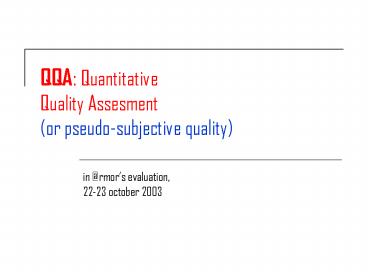QQA: Quantitative Quality Assesment (or pseudo-subjective quality)
Title:
QQA: Quantitative Quality Assesment (or pseudo-subjective quality)
Description:
QQA: Quantitative. Quality Assesment (or pseudo-subjective quality) in _at_rmor's evaluation, ... Quantitative evaluation of quality. as perceived by the observer, ... –
Number of Views:86
Avg rating:3.0/5.0
Title: QQA: Quantitative Quality Assesment (or pseudo-subjective quality)
1
QQA QuantitativeQuality Assesment(or
pseudo-subjective quality)
- in _at_rmors evaluation,22-23 october 2003
2
Global view
- QQA Quantitative Quality Assessment(or
pseudo-subjective quality assessment) - Quantitative evaluation of quality
- as perceived by the observer,
- automatically, and, if necessary, in real time.
- Idea to use specific learning tools (particular
open queuing networks) capturing the way human
react, taking measurable quantities as inputs. - Objective reached. Tested on video and audio
separately. Applications under analysis control
monitoring.
- Extensions under analysisto pricing, to
diffserv architectures, to traffic prediction and
bandwidth negotiation, to control issues in radio
access networks, to home networking.
3
The method
- Use a particularly performant statistical
learning toola product form queueing network
with positive and negative customers (a
G-network, or RNN) - to learn how humans react face to a multimedia
stream - after having passed through a packet network.
- Key points
- identify appropriate input variables (loss rate,
source bit rate, ) - a configuration a set of values for the input
variables - with each configuration associate a quality value
given by a set of real observers under controlled
conditions - find a G-network with the mapping
- input variables external arrival rates (of
positive customers) - only one queue sends customers outside, and the
quality is mapped to the load of this node - for each configuration, the load of the exit node
is (very) close to the quality given by the human
observers
4
Example of implementation for video
IP network
RNN
asking the source for BR, FR, RA
measuring LR, CLP
5
People
- For the remaining extensions
- B. Tuffin, CR INRIA,Y. Hezel, PhD student,for
pricing issues - J.-M. Bonnin, MdC ENST B,for mobile applications
- D. Ros, MdC ENST B,J. Orozco, PhD student,for
control in diffserv - L. Toutain, MdC ENST B,S. Ben Hamida, PhD
student,for control in home networking(condition
al to STREP accepted)
- G. Rubino, DR INRIA
- S. Mohamed,PhD (January 2003),now temporary
engineer - M. Varela, PhD student(starting his 2nd year)
- F. Cervantes, J. Incera, prof. at ITAM, Mexico,
for dynamic bandwidth negotiation
6
People
- For the remaining extensions
- B. Tuffin, CR INRIA,Y. Hezel, PhD student,for
pricing issues - J.-M. Bonnin, MdC ENST B,for mobile applications
- D. Ros, MdC ENST B,J. Orozco, PhD student,for
control in diffserv - L. Toutain, MdC ENST B,S. Ben Hamida, PhD
student,for control in home networking(condition
al to STREP accepted)
- G. Rubino, DR INRIA
- S. Mohamed,PhD (January 2003),now temporary
engineer - M. Varela, PhD student(starting his 2nd year)
- F. Cervantes, J. Incera, prof. at ITAM, Mexico,
for dynamic bandwidth negotiation
7
People
- For the remaining extensions
- B. Tuffin, CR INRIA,Y. Hezel, PhD student,for
pricing issues - J.-M. Bonnin, MdC ENST B,for mobile applications
- D. Ros, MdC ENST B,J. Orozco, PhD student,for
control in diffserv - L. Toutain, MdC ENST B,S. Ben Hamida, PhD
student,for control in home networking(condition
al to STREP accepted)
- G. Rubino, DR INRIA
- S. Mohamed,PhD (January 2003),now temporary
engineer - M. Varela, PhD student(starting his 2nd year)
- F. Cervantes, J. Incera, prof. at ITAM, Mexico,
for dynamic bandwidth negotiation
8
People
- For the remaining extensions
- B. Tuffin, CR INRIA,Y. Hayel, PhD student,for
pricing issues - J.-M. Bonnin, MdC ENST B,for mobile applications
- D. Ros, MdC ENST B,J. Orozco, PhD student,for
control in diffserv - L. Toutain, MdC ENST B,S. Ben Hamida, PhD
student,for control in home networking(condition
al to STREP accepted)
- G. Rubino, DR INRIA
- S. Mohamed,PhD (January 2003),now temporary
engineer - M. Varela, PhD student(starting his 2nd year)
- F. Cervantes, J. Incera, prof. at ITAM, Mexico,
for dynamic bandwidth negotiation
9
Publications
- A Study of Real--time Packet Video Quality Using
Random Neural Networks. S. Mohamed and G.
Rubino. IEEE Transactions On Circuits and Systems
for Video Technology, Vol. 12, No. 12, December
2002. - Performance evaluation of real-time speech
through a packet network a Random Neural
Networks based approach.S. Mohamed, G. Rubino
and M. Varela.To appear in Performance
Evaluation. - Other publications in
- Infocom 2001
- ICOIN15, 2001
- PDPTA2001
10
Next future
- develop a video-conference tool with automatic
quality control based on QQA - transform the approach into an industrial product
- Phillips? France Telecom?
- extend the approach in coupling traffic
prediction with dynamic negotiation of bandwidth - idea put a dynamic bandwidth negotiator at the
edge of the core - use QQA and traffic prediction ( a pricing
scheme) to allow the user to negotiate with the
provider - apply QQA to control in
- a diffeserv architecture
- a home network (together with reservation
techniques, network calculus tools and IPv6
facilities) - in pricing (to build virtual user profiles)
- to explore the interest of the same tools in risk
evaluation, and in compression techniques
11
Next future on the tool
- improve the mathematical analysis in the case of
recurrent networks - and then, apply it to the WAN design area
- improve the numerical algorithms used to analyze
the networks - basically, by adapting to G-networks specific
techniques that have proven to be efficient with
ANN































